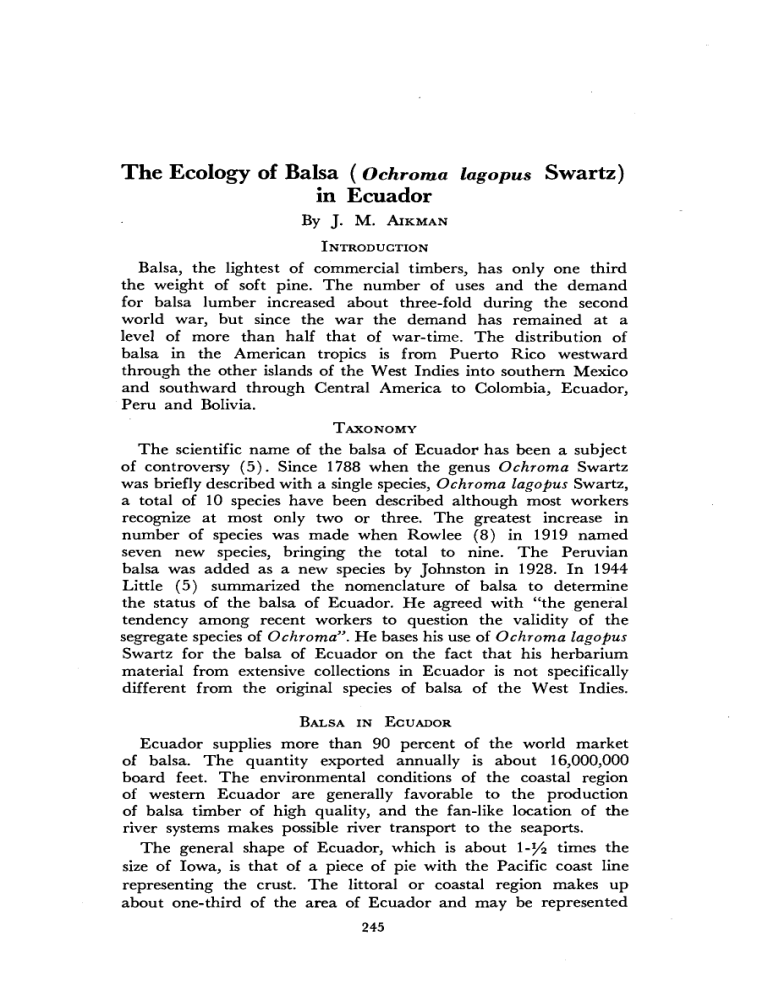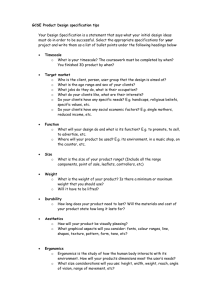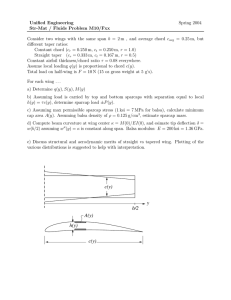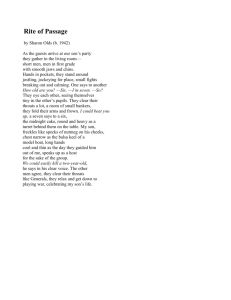
The Ecology of Balsa (Ochroma lagopus Swartz)
in Ecuador
By J. M. AIKMAN
INTRODUCTION
Balsa, the lightest of commercial timbers, has only one third
the weight of soft pine. The number of uses and the demand
for balsa lumber increased about three-fold during the second
world war, but since the war the demand has remained at a
level of more than half that of war-time. The distribution of
balsa in the American tropics is from Puerto Rico westward
through the other islands of the West Indies into southern Mexico
and southward through Central America to Colombia, Ecuador,
Peru and Bolivia.
TAXONOMY
The scientific name of the balsa of Ecuador has been a subject
of controversy (5). Since 1788 when the genus Ochroma Swartz
was briefly described with a single species, Ochroma lagopus Swartz,
a total of 10 species have been described although most workers
recognize at most only two or three. The greatest increase in
number of species was made when Rowlee (8) in 1919 named
seven new species, bringing the total to nine. The Peruvian
balsa was added as a new species by Johnston in 1928. In 1944
Little (5) summarized the nomenclature of balsa to determine
the status of the balsa of Ecuador. He agreed with "the general
tendency among recent workers to question the validity of the
segregate species of Ochroma". He bases his use of Ochroma lagopus
Swartz for the balsa of Ecuador on the fact that his herbarium
material from extensive collections in Ecuador is not specifically
different from the original species of balsa of the West Indies.
BALSA IN
ECUADOR
Ecuador supplies more than 90 percent of the world market
of balsa. The quantity exported annually is about 16,000,000
board feet. The environmental conditions of the coastal region
of western Ecuador are generally favorable to the production
of balsa timber of high quality, and the fan-like location of the
river systems makes possible river transport to the seaports.
The general shape of Ecuador, which is about 1-~ times the
size of Iowa, is that of a piece of pie with the Pacific coast line
representing the crust. The littoral or coastal region makes up
about one-third of the area of Ecuador and may be represented
245
246
IOWA ACADEMY OF SCIENCE
[Vol. 62
by that third of the piece of pie next to the crust. This coastal
strip extending generally north and south is bordered on the east
by the western slope of the Andes. The width of this strip is
about 50 miles near the Colombian border at the north, 100 miles
in the middle part and about 20 miles near the Peruvian border
at the south. The climate is progressively drier southward. A strip
of higher elevation bordering the coast. from the mid-point southward is generally too dry for balsa. (3, 6).
The area delimited as above constitutes the balsa producing
region of Ecuador. The elevation of the greatest portion of the
area is less than 500 feet, although along its eastern border it may
extend up the western slopes of the Andes to an elevation of
2500 feet. Along this entire eastern border it is in contact with
the mountain forest covering the western slopes of the Andes from
an elevation of 2000 or 2500 feet to 9000 or 10,000 feet. (7, 9).
The vegetation of this region in Ecuador in which balsa grows
is classified as wet tropical forest in contrast to the tropical rain
forest which occurs in Colombia (3). In spite of the occurrence
of a dry season of a few to eight months duration, the general
appearance of this forest closely resembles the true tropical rain
forest. In virgin stands stratification is well developed. The trees
are broad-leaf evergreens. The upper canopy of the forest is
well over 10J feet. Many vines and epiphytes are present (1). There
is a very large number of species, and constancy among different
stands of apparently the same community is very low.
EXPERIMENTAL AREA
The experimental area is located on the middle branch of the
Guayas river system about 100 miles north of Guayaquil. It is
about 12 miles east of the foothills of the Andes and midway
north and south in the wet tropical forest. This area was selected
because a large proportion of high quality balsa logs exported
from Ecuador are obtained from this locality and rafted down
the Quevedo river from Quevedo and adjacent towns (4). It
was at Quevedo that Thor Heyerdahl, the author of "Kon-Tiki",
and his crew obtained the balsa logs for the raft on which they
crossed the Pacific (2). Weather data for this experimental area
were taken from the records of the weather station at Cooperative
Tropical Experiment Station located on the Quevedo river 15
kilometers south· of Quevedo. The growth measurements and other
data were obtained in the wet tropical forest of a strip extending
about 3 kilometers on each side of the river for a distance of
about 20 kilometers north and south of the tropical station.
1955]
BALSA IN ECUADOR
247
ENVIRONMENTAL FACTORS
The soils of the Andean outwash plain of this area are fine,
sandy, and clay loams chiefly of volcanic origin. They are for
the most part colluvial and alluvial and extend in depth beyond
the limits of root growth of the balsa. Where tested in the vicinity
of the tropical station, they were very slightly acid. On recently
cleared and burned areas where most of the balsa trees grow,
the soil has a friable structure to which may be attributed the high
rate of percolation during the rainy season and the high waterholding capacity. In the experimental plots at the Tropical station
it was possible to grow a second crop of com, planted after
the rains had ceased about the middle of May, and watered only
from the moisture held in the soil. This condition is a very
important factor in the growth of balsa stands.
Rainfall data in inches per month for a ten-year period are
presented in Figure 1. Two facts are very apparent from the
graph; the occurrence of a wet and dry season and the high
variability from year to year. The curves for the years 1952 and
1953 as well as the average curve for the lO-year period are
shown because these two successive years represent an extremely
wide variation. Plant growth conditions are not as unfavorable
during the dry season as would be expected. During the wet
season rain falls almost every night and there is bright sunshine
for about half of each 12-hour daytime period. During the dry
season however the sky is continuously overcast with a corresponding lowering temperature and a reduction in vapor pressure deficit.
The terms are relative but the wet season is the "hot" season (84° F.
maximum average) and the dry season is the "cool" season
(80° maximum average).
Another ameliorating influence on the climate is the occurrence
of "garua", a heavy morning fog or mist which persists until
8 to 10 o'clock. During the first month of the dry season, "garua"
usually occurs 22 to 24 times. The number of mornings "garua"
occurs is reduced more or less gradually until the final month
of the dry season when it may occur only 10 to 12 times.
Temperature, humidity, and wind data as monthly avera.ges
for 1952 and for the first 10 months of 1953 are shown in a
graph in Figure 2. Contrasted to the wide variation in rainfall
per month and per year, the variation in temperature and humidity
from year to year are very slight and the daily variations within
a given year are not great: 91 to 66° F. in temperature and 100
to 60 percent in humidity. The average monthly minimum
[Vol. 62
IOWA ACADEMY OF SCIENCE
248
40r---------------------------,
- - AVERAGE RAINFALL, 1945 -1953
- - - RAINFALL, 1953
•••••••• RAINFALL, 1952
8
.
30
o RAINFALL PER MONTH
o
'"
o
\oJ
~ 20
o
o
o
0
z
:.... . ~
'
..•.0
10
o
0 ...
o
o
o
olh----d-,~-=-----:-h---.,~#~~~~~~JJ
SEPT.
OCT.
FIG.I RAINFALL IN INCHES PER MONTH AT THE TROPICAL EXPERIMENT
STATION.
humidities are not given in Figure 2. The lowest value was for
the month of November 1952: 69.6 percent. The average vapor
pressure deficit for this driest month of the 20, based on the
monthly average daily humidity and temperature, was 3.54 mm.
of mercury. The average vapor pressure deficit for June, 1952,
the least dry month, 1.48. A difference of such low magnitude
would have little or no effect on the transpiration rate of plants.
Under soil moisture conditions which seldom approach the wilting
percentage at any great depth, drought is seldom if ever a factor
in the development of a balsa stand under natural conditions
unless the stand is greatly overstocked. The monthly average
100
f.-- v
V /'""' r-•.. >we
.. 90
,:
-
V
~~ 80 f-
:;;'"
"'w
w>
0.-
~~ 70 0::::-
>-iil
..........
r-........-
r-........- , /
60 r3f--
I--
-
- -........
/
-
f""'-...f"..._I--_I--f-f'..-.
__ f.--I--
MONTHLY AvERAGES'
'"
I-
f--
-
I. MAXIMUM RELATIVE HUMIDITY
2. DAILY AvERAGE RELATIVE HUMIDITY
3.MAXIMUM AIR TEMPERATURE
4. DAILY AVERAGE AIR TEMPERATURE
5. MINIMUM AIR TEMPERATURE
6. WINO. MILES RER HOUR
..........
...- ..........
r--.. ~
..........
........
.........
......... r-- V N
.........
--
r-- V N
r--.. V N
6.
o
J
MAMJJASONDJ
1952
MAMJJASO
1953
FIG.2 TEMPERATURE. HUMIDITY AND WIND DATA AT THE TROPICAL
EXPERIMENT STATION.
1955]
BALSA IN ECUADOR
249
wind velocity does not exceed 2 miles per hour but air movement
is very constant from day to day and from month to month.
The absence of high winds in the central and eastern part of the
coastal region of Ecuador is an important factor in the development of balsa, which is not well adapted to growth in regions
of high wind velocity.
GROWTH HABIT AND RESPONSE OF BALSA TO ENVIRONMENT
The balsa in Ecuador is a fast-growing, short-lived tree with
heart-shaped leaves mostly 8 to 14 inches in length. Larger leaves
on young trees and on shaded and succulent branches are common. Young trees in close stands have slender, sparsely branched,
almost spindly stems. In open stands young trees may branch
profusely and broadly. The succulent, browish-green flowers are
usually about 5 to 7 inches long and almost as wide. The fruit
is an elongate, 5-valved, dehiscent capsule whose shape and short,
brown, silky, hair-like fibers suggested the specific name "lagopus",
rabbit's foot. Each pod contains about 1000 seeds which are
enveloped by a brownish down of connected fibers. The seeds
are elongate and very small and light. There are about 50,000
to 60,000 clean seeds to a pound.
The pods begin to fall toward the close of the dry season. The
capsules open as they dry, releasing the light brown, finely fibrous
material which is very inflammable. The fact that the seed are
borne in this manner and readily released by burning is the first in
a chain of circumstances which account for the role of balsa as
a pioneer species in the wet tropical forest. When the "monte"
(forest) has been cleared for a patch of upland rice and corn
and, after drying, is burned, thousands of little piles of balsa floss
explode with bursts of flame, releasing millions of tiny seeds in
the soil. Balsa seed may remain viable in the soil for several
years, which insures a contant seed supply in areas where the
"rotation" usually calls for reclearing, burning and cropping
every three or four years.
The chief characteristic that accounts for the classification of
the balsa as a pioneer species in the reestablishment of forest stands
following clearing and burning or other disturbance is the extreme
intolerance of balsa to shades. There is scarcely a tree species in
the wet tropical forest which cannot shade out the balsa when
it reaches an equal or greater height. However, the rapid growth
of balsa assures its dominance in occasional small areas where
conditions for its establishment have been sufficiently favorable
to produce fully stocked stands. In these stands dominance may be
maintained for 8 to 10 or more years, until most of the trees are
large enough for cutting. The trees of the last four age groups in
Figure 3 were cut from such stands. The trees of the first four age
groups were growing in similar but younger fully stocked stands.
[Vol. 62
IOWA ACADEMY OF SCIENCE
250
The sigmoid curve of the graph represents the rate of growth
of balsa for the first 8 years as accurately as it can be constructed
from different fully stocked stands growing under natural conditions. Figure 4 is a picture of a part of a natural, fully stocked
stand of balsa. None of the trees is older than 7 years. Some of
the trees in this stand are slightly larger than the trees in the
cut stands from which the upper part of the curve in Figure 3 was
constructed.
Generally balsa stands are not sufficiently well-stocked to compete among themselves and therefore make more rapid growth
than completely stocked stands for as long as their crowns remain
above the canopy of slower growing, more tolerant species. These
may attain near maximum height growth for the species (about
100 feet) and D.B.H. measurements of 25 to 36 or more inches.
In such mixed stands the balsa is usually not dominant. The
sigmoid curve representing the growth of these trees has a more
upright and longer grand period of growth line, extending from
about the third year to the seventh or eight year, than the curve
in Figure 3. Beyond this point it flattens off more slowly.
Over large areas of the wet tropical forest, occasional balsa
trees grow alone, or in two's and three's, in the stand of mixed
hardwoods whenever there is sufficient space for a quick growing
intolerant tree or two to become established and an adequate
break in the canopy for their crowns to receive sufficient light
for development. In openings of sufficient size, these occasional
balsa trees may attain sizes as great as 42 to 48 inches D.B.H.
and to 120 feet or more high. The sigmoid growth curve of
some of these trees may be the most upright of all. However,
balsa trees that attain diameters much in excess of 20 inches
11
~ IJU
o
o
o
o
o
a:
w
I-
W
~
5
<:
o
o o~::=:::"----.J'-=-----l:--------c!:3"---------!-4--~5--~6--~---;;---~9
AGE OF BALSA TREES IN YEARS
FIG. :3 CURVE OF RATE OF GROWTH OF BALSA IN STANDS
OOM I NATE 0 BY TH IS SPEC IES.
1955]
BALSA IN ECUADOR
251
are likely to contain water-heart and are of little commercial
value.
Balsa trees, because of their constant seed supply and rapidity
of growth following germination in cleared areas, become established readily in clearings of any size. Their extreme intolerance
contributes to their adaptability to the plant growth conditions
of the wet tropical forest rather than to those of the tropical rain
forest where an intolerant, pioneer species would be subjected
to a lower degree of light intensity than it could endure. Because
of this fact the balsa is admirably adapted to growth in the wet
tropical forest and especially in those portions of it which have a
dry season of about 6 months duration. Under the conditions of
overcast skies during the dry season, the occurrence of "garua"
and the fertile, high water-holding capacity soils of volcanic
origin, the balsa can endure the dry season and still maintain a
greater rate of growth than many of the more tolerant tree
species. Under these conditions it has an advantage when growing
in competition with these species which it would not have if the
rainfall were greater and more constant, and therefore conditions
favorable for the rapid growth of more tolerant species.
At the present time there is enough balsa to supply the demand
by harvesting those trees which grow more or less naturally in
cleared and other open areas with very few control practices.
As the demand increases, which seems very likely, the supply
can be greatly increased by more careful control of the growth
conditions of the balsa. This control can be attained more easily
in regions in which the soil and climate conditions resemble very
closely those in the vicinity of the tropical experiment station in
the Quevedo area rather than in the more humid areas northward.
Shade control for example will be much easier here where fewer,
more tolerant trees must be suppressd than would be necessary
with more rainfall over a longer period.
Clearing of cut-over land especially for balsa production would
be the first step in a program to increase the supply of balsa
in these favorable areas. Harvesting a crop or two of rice and
corn before balsa is allowed to come in greatly reduces the quantity
and quality of balsa produced. Fostering the establishment of
stands as that shown in Figure 4, except much -larger in area,
would not be difficult if the seedlings were allowed to develop
naturally following clearing and burning instead of weeding out
the young trees for a year or two as is the practice in the present
cropping procedure. Girdling or felling young trees of more tolerant species as necessary to make canopy room for the balsa trees
as they develop is not too laborious or expensive. After the middle
of the third year the young fully stocked stand would require
no more care until cutting time.
252
IOWA ACADEMY OF SCIENCE
IVol. 62
-~
F;guce 4. Pan of a lully__",ocked '.}~ar ..a"d 01 bal",,- approximatel~ one ac« in
ute"'. Numher I><"r aCre 1:;W, D.II.II. '0 N inche., heigh. '0 70 fed. Tropical Ex_
I"',imcnt Stat;., .. , AUgull, 19....3.
Uleralurc Cited
I. Greenhouse, Samuel. 1935. The culture of the balsa tree in Ecuador.
Jour. For. 33:870-876.
2. Heyerdahl, Thor. 1947. Kon·Tiki: across the Pacific by raft. Trans!.
F. H. Lyon. 1950. Rand McNall}', Chicago.
3. Holdridge, L. R. et.al. 1947. The forests of western and central Ecuador.
Forest Service, V.S.D.A.
4. l'lorn, Eugene F. Growing balla in western Ecuador. Caribb. For.
7:285-289.
5. Little, Elbert L. Jr. 1944. Ochroma IDgOPUS Swartz, the name of the
balsa in Ecuooor. Caribb. For. 5:108-(14.
6. Orellana B., Rodrigo. 1941. La balsa, arbol de la floresta eeuatoriana.
Baneo Hipoteeario del Ecuador 5(9):37-59.
7. Rimbaeh, August. 1932. The forests of Ecuador. Tropical Woods 31:1-9.
8. Rowlee, W. W. 1919. Synopsis of the genus Ochroma, with description
of new species. Wash. Acad. Sci . .Jour. 9: 157.167.
9. Teesdale, Laurence V. 1943. Production, scasonin~ and shipping of
balsa. Timbennan 44(11):38-43; 44(12):37·44; 45(1):20·28.
DEPARTMENT OF BoTANY ANI) PLANT PATHOLOCY
IOWA STATE COLLEGE
AMES, IOWA






